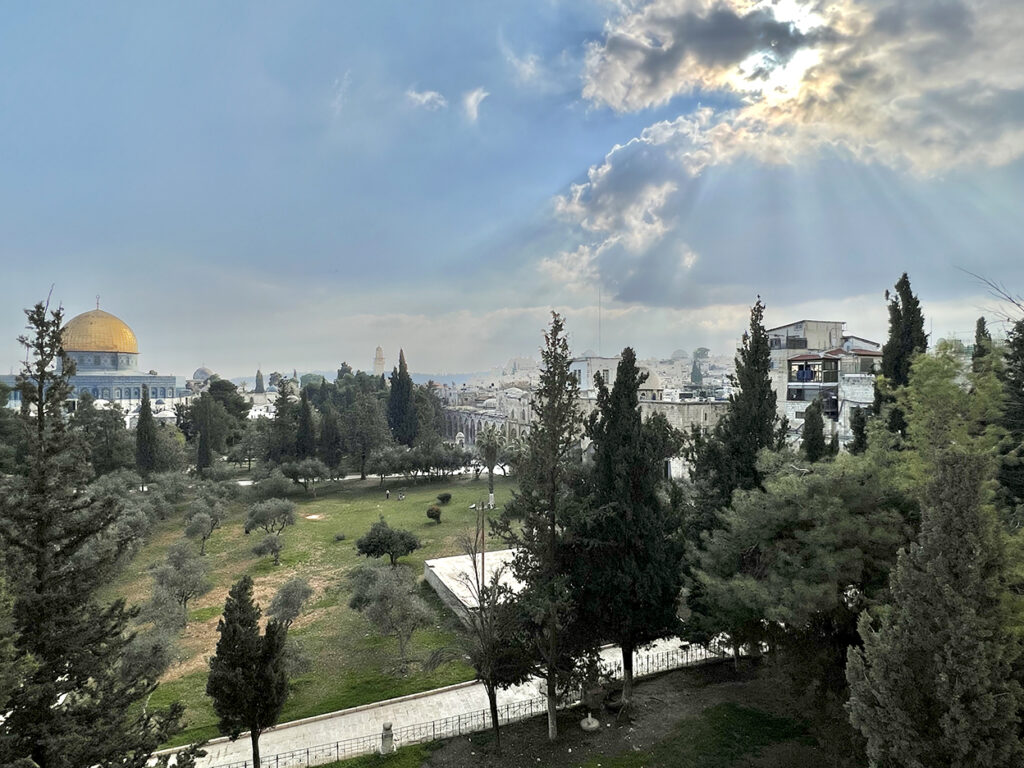
By Pam Johnson
Editor’s Note: Pam Johnson and her husband Woody are in the midst of a yearlong trip abroad, visiting 12 countries in 12 months. Pam will file monthly stories along the way.
How to find the appropriate words to capture the overwhelming feeling of being by the Sea of Galilee, where Jesus lived? Or walking through the Garden of Gethsemane, where he prayed? Or standing on Mt. Carmel, where the prophet Elijah once stood?
I felt like Indiana Jones did when he discovered the Ark of the Covenant or held the Holy Grail: an indescribable awe, though, unlike Indiana Jones, my encounter was real and spiritual.
Growing up in a Christian family, I’ve heard Bible stories all my life. So as a believer, the idea of a visit to Israel resonated with me. And I was not disappointed.
Israel is a magnificent place no matter what your beliefs. Everywhere you turn, there is something to see and learn. Whether you’re a historian, an archeologist, a religious person, or just deeply curious about the country, one could spend years exploring and not absorb it all.
Since we were able to take our time in some places but had to hurry through others, I discovered that “seeing” is very different than “experiencing.” We “saw” the sites in Jerusalem: the Rock of Ascension, the Via Dolorosa, the Garden of Gethsemane, the Pools of Bethesda, and many more.
Though very meaningful, these places were crowded, and being on a tour, we felt rushed. I did have a solitary moment in the Garden, but how I longed to sit and ponder and truly grasp the feeling of being there.

Thus, the Sea of Galilee was our highlight in Israel. We spent the month in Tiberias, on the shores of the sea, so we had time to really experience this area. I relished the sounds and sights of everything around the sea: the flocks of birds, the lapping of the waves, the sudden storms, the occasional fish jumping from the water, and the serene mountains and valleys.
It was not difficult to imagine life in the 1st century while walking along the beach or sitting quietly to take it all in.
The view from our apartment was the northside of the sea, so every morning I’d wake up to that view and contemplate those who had lived there during the time of Christ. We could see the location of Capernaum — where Jesus began his ministry and met many of his disciples including Simon Peter, Andrew, John, and James; the Mount of Beatitudes — where Jesus gave the Sermon on the Mount; Tabgha — where the miracle of the two fish and five loaves occurred; and many more significant sites.
What makes the Sea of Galilee so emotionally moving is that compared to Jerusalem, where the city has changed so much since the days of Jesus, the area seems practically untouched. It probably doesn’t look a whole lot different than when Jesus lived there 2,000 years ago. Also, there are ongoing excavation sites at Capernaum, Tiberias, and Magdala, where they are continually unfolding life from the 1st century.
The spiritual connection was our most prevalent impression of Israel, but there is more. The beauty of the mountains, the countryside, and even the desert is absolutely worth a visit.
The city of Haifa is spectacular, ascending the side of a mountain with a breathtaking view from the top. Old Jerusalem is a splendid center of culture, religion, and history. The coast of the Mediterranean has gorgeous beaches and glorious sunsets. And majestic Mount Hermon, in the north, was capped with snow.
A very interesting cultural component of Israel is the kibbutz. Back in my college days, I had heard of graduates often taking a few months before beginning their careers to either backpack across Europe or work on a kibbutz in Israel.
I didn’t realize that’s still a thing. In a nutshell, a kibbutz is a commune, typically centered around agriculture, but these days, also tourism. There are currently around 270 of them. The members contribute their labor to the kibbutz, and in exchange, their basic necessities are provided. I think volunteering at a kibbutz would be a great way to see Israel and would give an intriguing insight into life in Israel.
Then, last but never least, there’s the Israeli food: falafel, baba ganoush (smoked eggplant), hummus, olives, fish, tabbouleh, dolmas, dates, tahini, latkes, and so much more. Because eating out was a bit pricey in Israel, compared to Morocco and some of our other countries, we didn’t eat at restaurants very often. But when we did, it was well worth the price we paid.
The beauty, the culture, the food, the people— all of Israel is wonderful.
However, if we ever return, it will be the Sea of Galilee that calls us:
O, Sea of Galilee
My soul, it stirs at the sight of thee,
Awareness of my Savior here
His footsteps on your rocky shores
His eyes on these rolling hills
His breath on the gentle breeze
My heart is full, my doubts are gone,
My spirit humbled
Looking over your water touched by His hand.
If you’d like to hear more about our travel adventures and see more photos, please visit my blog site at pamtheeditor.wixsite.com/amimionthemove and follow me on Instagram and TikTok @amimionthemove. Check back next month for the next stop on the Johnsons’ journey.



